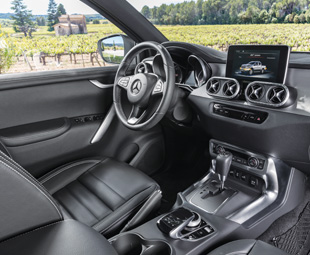The X factor!

“Pah. It’s a Datsun with a radio,” a mate of charleen clarke commented, when she told him she was attending the world premiere of the Mercedes-Benz X-Class. He was, of course, alluding to the underpinnings that the bakkie shares with the Nissan Navara (and Renault Alaskan, for that matter). He could not have been more wrong
There was a lot of grumbling from journalists, who attended the world premiere of the X-Class, when they discovered that they wouldn’t actually be driving the bakkie. They were wrong to complain. Mercedes-Benz always adopts a three-pronged approach when launching a new vehicle.
First, there is the reveal (generally of a concept). Then there is the premiere (we look at the vehicle and ooh and ah – it may be driven onto a stage, but that’s it in terms of driving). The third event is the actual launch; when petrol and diesel heads get behind the wheel and go for a spin.
With the X-Class world premiere, Mercedes-Benz broke with tradition. Not only did the X-Class move a lot, but we were actually taken for a 15-minute drive. Yes, we were sitting in the passenger seat – but this gave us a good indication of the vehicle and its capabilities (especially given the fact that we were driven on tar as well as on dirt).
 So, what’s the new X-Class like? Is it really a Datsun with a radio? Nothing could be further from the truth.
So, what’s the new X-Class like? Is it really a Datsun with a radio? Nothing could be further from the truth.
First, it doesn’t look like the Nissan Navara or its sister model, the Renault Alaskan – especially not up front, which screams “Mercedes-Benz”. It’s extremely bold; it looks a bit like an American pickup morphed into a Mercedes-Benz SUV. The star is centrally positioned and it’s complemented by a twin-louvre radiator grille, a high and powerfully honed bonnet and headlamps extending far into the wings.
There are three design and equipment lines, namely Pure, Progressive and Power. Even the entry-level Pure models (for want of a better description, because they’re actually not “entry-level” at all) are very well spec’d.
This is because the X-Class isn’t being positioned as a workhorse; it’s aimed at pickup owners who want a bakkie with passenger-car characteristics in terms of performance, safety, design and comfort. It’s also aimed at passenger-car drivers. As such, while the Pure does have black bumpers, it still looks like a stylish and elegant vehicle.
 In keeping with motor industry tradition, the Progressive and Power gain more chrome and bling as one moves up the spec and pricing levels.
In keeping with motor industry tradition, the Progressive and Power gain more chrome and bling as one moves up the spec and pricing levels.
Step inside the vehicle and there is also absolutely no resemblance to the Navara or Alaskan (I took a really good look and the only similarity that I could find is the seat adjustment). In fact, the interior smacks of a luxury car; you could be forgiven for thinking that you’re in a C-Class – it’s thoroughly Mercedes-Benz.
The ride is also very Mercedes-Benz like. While the X-Class shares some of its underpinning with its Nissan and Renault siblings (for instance, it boasts a ladder-frame platform and uniquely tuned version of the chassis used beneath the Navara and Alaskan), the ride quality is more akin to a SUV than a bakkie.
Significantly, it boasts coil springs front and rear. The front wheels are guided by double triangle wishbones. At the back, a rear multi-link solid axle with a good articulation capability is well suited to transporting heavy loads.
 This combination ensures that the suspension is comfortable and the handling is safe under any load (it can transport a payload of up to 1,1 t). Furthermore, the X-Class has internally vented disc brakes front and rear.
This combination ensures that the suspension is comfortable and the handling is safe under any load (it can transport a payload of up to 1,1 t). Furthermore, the X-Class has internally vented disc brakes front and rear.
At launch (we’ll get the X-Class in April next year), two 2,3-litre diesel engines and one petrol engine – all supplied by the Renault-Nissan alliance – will be up for grabs.
In the X220d with single turbocharger the diesel engine generates 120 kW and, in the biturbo X250d, no less than 140 kW. The X200’s petrol engine generates 122 kW. (We won’t get this model; it will only be available as a left-hand drive vehicle with rear-wheel drive, and it will be destined for markets such as Dubai and Morocco.)
I rode in the X250d. Its biturbo engine has two turbochargers of different sizes, which, depending on the engine speed, compress the intake air either singly or in combination.
This delivers powerful torque at low revs and more output at the top end of the rev range. It appeared to deliver immediate response, good pulling power and strong acceleration over the short route.
Both diesel variants are available as purely rear-wheel drive, or with engageable all-wheel drive. Power is transferred via a six-speed manual transmission.
 Its special feature is the wide transmission spacing, with a short first gear for maximum torque and a long sixth gear to keep rev speeds down. This design makes allowance for typical situations such as hill starts with a horse or boat trailer in tow, and long-distance comfort on motorways.
Its special feature is the wide transmission spacing, with a short first gear for maximum torque and a long sixth gear to keep rev speeds down. This design makes allowance for typical situations such as hill starts with a horse or boat trailer in tow, and long-distance comfort on motorways.
Furthermore, the manual transmission combined with a diesel engine can be equipped with the ECO start/stop function as an option in various markets. This makes an important contribution to the X-Class’s moderate fuel consumption.
As soon as the driver brakes, disengages the gear and releases the clutch, the engine switches off automatically when the vehicle is at a standstill. When the clutch is engaged, the engine immediately starts again. This saves on fuel, particularly in urban traffic.
In mid-2018, the top-of-the-range, high-torque V6 diesel engine will be released, ensuring even greater agility on- and off-road. This powerplant will be sourced from Daimler. We know it well; it’s already proven its credentials in numerous Mercedes-Benz passenger car models – from the G-Class to the latest E-Class.
 The top X-Class model will come as standard with permanent 4MATIC all-wheel drive and the seven-speed 7G-TRONIC PLUS automatic transmission. It will boast steering-wheel shift paddles and the ECO start/stop function. (We asked if an AMG model could be expected; the answer was a resounding “no”!)
The top X-Class model will come as standard with permanent 4MATIC all-wheel drive and the seven-speed 7G-TRONIC PLUS automatic transmission. It will boast steering-wheel shift paddles and the ECO start/stop function. (We asked if an AMG model could be expected; the answer was a resounding “no”!)
In typical Mercedes-Benz fashion, the X-Class will boast nothing less than exemplary levels of passive and active safety equipment (including Active Brake Assist, Lane Keeping Assist and Traffic Sign Assist).
The X-Class will be produced at plants owned by Daimler and its alliance partner Renault-Nissan located in Spain and Argentina. The Renault and Nissan bakkies will be produced in the same facilities. We will be driving the X-Class in October; watch this space for a full report on the king of pickups in our December issue!
Published by
Focus on Transport
focusmagsa




